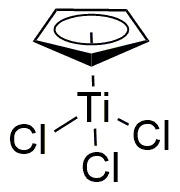Cyclopentadienyltitanium(IV) trichloride is widely utilized in research focused on:
- Organometallic Chemistry: This compound serves as a key precursor in synthesizing various organometallic complexes, which are essential for developing new catalysts and materials.
- Catalysis: It is used in catalytic processes, particularly in polymerization reactions, helping to produce high-performance polymers with desirable properties.
- Material Science: Researchers leverage its properties to create advanced materials, such as thin films and coatings, which are crucial in electronics and aerospace industries.
- Pharmaceutical Development: The compound plays a role in synthesizing biologically active molecules, aiding in the discovery of new drugs and therapeutic agents.
- Environmental Applications: Its use in developing catalysts for environmental remediation processes highlights its potential in addressing pollution and sustainability challenges.
General Information
Properties
Safety and Regulations
Applications
Cyclopentadienyltitanium(IV) trichloride is widely utilized in research focused on:
- Organometallic Chemistry: This compound serves as a key precursor in synthesizing various organometallic complexes, which are essential for developing new catalysts and materials.
- Catalysis: It is used in catalytic processes, particularly in polymerization reactions, helping to produce high-performance polymers with desirable properties.
- Material Science: Researchers leverage its properties to create advanced materials, such as thin films and coatings, which are crucial in electronics and aerospace industries.
- Pharmaceutical Development: The compound plays a role in synthesizing biologically active molecules, aiding in the discovery of new drugs and therapeutic agents.
- Environmental Applications: Its use in developing catalysts for environmental remediation processes highlights its potential in addressing pollution and sustainability challenges.
Documents
Safety Data Sheets (SDS)
The SDS provides comprehensive safety information on handling, storage, and disposal of the product.
Product Specification (PS)
The PS provides a comprehensive breakdown of the product’s properties, including chemical composition, physical state, purity, and storage requirements. It also details acceptable quality ranges and the product's intended applications.
Certificates of Analysis (COA)
Search for Certificates of Analysis (COA) by entering the products Lot Number. Lot and Batch Numbers can be found on a product’s label following the words ‘Lot’ or ‘Batch’.
*Catalog Number
*Lot Number
Certificates Of Origin (COO)
This COO confirms the country where the product was manufactured, and also details the materials and components used in it and whether it is derived from natural, synthetic, or other specific sources. This certificate may be required for customs, trade, and regulatory compliance.
*Catalog Number
*Lot Number
Safety Data Sheets (SDS)
The SDS provides comprehensive safety information on handling, storage, and disposal of the product.
DownloadProduct Specification (PS)
The PS provides a comprehensive breakdown of the product’s properties, including chemical composition, physical state, purity, and storage requirements. It also details acceptable quality ranges and the product's intended applications.
DownloadCertificates of Analysis (COA)
Search for Certificates of Analysis (COA) by entering the products Lot Number. Lot and Batch Numbers can be found on a product’s label following the words ‘Lot’ or ‘Batch’.
*Catalog Number
*Lot Number
Certificates Of Origin (COO)
This COO confirms the country where the product was manufactured, and also details the materials and components used in it and whether it is derived from natural, synthetic, or other specific sources. This certificate may be required for customs, trade, and regulatory compliance.


